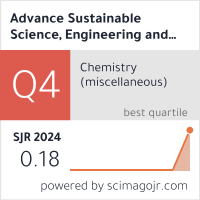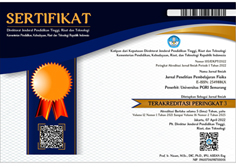Scenario-Based Dynamic Modeling for Urban Settlement Management
DOI:
https://doi.org/10.26877/asset.v7i3.1953Keywords:
dynamic simulation, urban system modeling, sustainable settlement area, periurban development, land-use controlAbstract
The growth of residential areas in peri-urban regions of metropolitan areas such as Jabodetabek demonstrates high complexity due to the dynamic interaction between population growth, land use, and environmental degradation. This study aims to develop a dynamic system-based simulation model using a scenario approach to analyze sustainable residential area management policies. The scenarios were developed consists of no intervention, pessimistic, moderate, and optimistic based on parameters such as local government commitment, regional capacity improvement, and the rate of incoming migration. The simulation results indicate that the optimistic scenario is the most effective in controlling population size (a reduction of 29.14%), limiting residential expansion (a 58.57% decrease in the settlement area ratio), and improving the quality of the physical environment (a 95.18% increase) by the year 2040. The findings recommend strengthening spatial planning policies through enhanced cross-sectoral coordination, vertical housing development, and migration control. Although the model has limitations due to its assumption of a fixed system and the exclusion of external dynamics, this research provides valuable insights for the development of dynamic system-based policies in the sustainable planning of complex metropolitan regions.
References
[1] Ahani S, Dadashpoor H. Urban growth containment policies for the guidance and control of peri-urbanization: a review and proposed framework. Environ Dev Sustain 2021;23:14215–44. https://doi.org/10.1007/s10668-021-01268-5.
[2] Seifollahi-Aghmiuni S, Kalantari Z, Egidi G, Gaburova L, Salvati L. Urbanisation-driven land degradation and socioeconomic challenges in peri-urban areas: Insights from Southern Europe. Ambio 2022;51:1446–58. https://doi.org/10.1007/s13280-022-01701-7.
[3] Narayani AR, and Nagalakshmi R. Understanding urban sprawl trends in peri urban regions across global cities - survey of case studies. Cities Health 2023;7:492–504. https://doi.org/10.1080/23748834.2022.2106771.
[4] Sarje SH, Kumbhalkar MA, Washimkar DN, Kulkarni RH, Jaybhaye MD, Al Doori WH. Current Scenario of Maintenance 4.0 and Opportunities for Sustainability-Driven Maintenance. Advance Sustainable Science, Engineering and Technology 2025;7:1–14. https://doi.org/10.26877/asset.v7i1.1028.
[5] Putri AD, Putra INDP, Yunisya AN. Exploration of Identification at Each Phase to Advance Productivity Towards Sustainable Practices. Advance Sustainable Science, Engineering and Technology 2025;7:1–13. https://doi.org/10.26877/asset.v7i2.1333.
[6] Noviani R, Marfu’ah IN. Spatial patterns analysis of land use changes using spatial metrics in the peri-urban area of Surakarta City 2023. IOP Conf Ser Earth Environ Sci, vol. 1314, IOP Publishing; 2024, p. 12089. https://doi.org/10.1088/1755-1315/1314/1/012089.
[7] Sareen S, Haque M. The dynamics of Peri-Urban spatial planning: An overview. J Urban Plan Dev 2023;149:3123002.
[8] Jatayu A, Saizen I, Rustiadi E, Pribadi DO, Juanda B. Urban form dynamics and modelling towards sustainable hinterland development in North Cianjur, Jakarta–Bandung Mega-Urban Region. Sustainability 2022;14:907.
[9] Asadzadeh A, Kötter T, Fekete A, Moghadas M, Alizadeh M, Zebardast E, et al. Urbanization, migration, and the challenges of resilience thinking in urban planning: Insights from two contrasting planning systems in Germany and Iran. Cities 2022;125:103642. https://doi.org/https://doi.org/10.1016/j.cities.2022.103642.
[10] Younan MN, El-Kholei AO, Yassein GA. Urban metabolism and dynamic modeling: pioneering approaches for resilient planning in the Greater Cairo Region. Environ Dev Sustain 2024;26:25091–112. https://doi.org/10.1007/s10668-023-03671-6.
[11] Hidayat JT, Ridwan M. Assessment of the quality of public Green Open Space (GOS) in the urban fringes in response to urban sprawl phenomenon (case study District of Tanah Sareal, Bogor City). IOP Conf Ser Earth Environ Sci, vol. 179, IOP Publishing; 2018, p. 012027.
[12] Li L, Huang X, Yang H. Scenario-based urban growth simulation by incorporating ecological-agricultural-urban suitability into a Future Land Use Simulation model. Cities 2023;137:104334. https://doi.org/https://doi.org/10.1016/j.cities.2023.104334.
[13] Ghadirian O, Lotfi A, Moradi H, Shetab Boushehri SN, Yousefpour R. Area-based scenario development in land-use change modeling: A system dynamics-assisted approach for mixed agricultural-residential landscapes. Ecol Inform 2023;76:102129. https://doi.org/https://doi.org/10.1016/j.ecoinf.2023.102129.
[14] Chammout B, Khalef R, El-adaway IH. A System Dynamics Model for Urban Sprawl and Its Impact on Sustainability. CIB Conferences, vol. 1, 2025, p. 384.
[15] Feofilovs M, Romagnoli F. Dynamic assessment of urban resilience to natural hazards. International Journal of Disaster Risk Reduction 2021;62:102328. https://doi.org/https://doi.org/10.1016/j.ijdrr.2021.102328.
[16] Lu L, Qureshi S, Li Q, Chen F, Shu L. Monitoring and projecting sustainable transitions in urban land use using remote sensing and scenario-based modelling in a coastal megacity. Ocean Coast Manag 2022;224:106201. https://doi.org/https://doi.org/10.1016/j.ocecoaman.2022.106201.
[17] Ye Y, Liu Y, Liu J, Weng Z, Chang Z, Li X. Driving Factors of Urban–Rural Human Settlement Changes and a Multi-Scenario Simulation Based on SDGs. Ecosystem Health and Sustainability 2025;11:300.
[18] Sedighi E, Salmanmahiny A, Fath BD, Daliri H. A spatial scenario planning framework for land use decision-making: case study of Gorgan township, Iran. Environ Dev Sustain 2024. https://doi.org/10.1007/s10668-024-04639-w.
[19] Datola G, Bottero M, De Angelis E, Romagnoli F. Operationalising resilience: A methodological framework for assessing urban resilience through System Dynamics Model. Ecol Modell 2022;465:109851. https://doi.org/https://doi.org/10.1016/j.ecolmodel.2021.109851.
[20] Rezvani SMHS, Falcão MJ, Komljenovic D, de Almeida NM. A systematic literature review on urban resilience enabled with asset and disaster risk management approaches and GIS-based decision support tools. Applied Sciences 2023;13:2223.
[21] Ševčíková H, Nichols B. Land use uncertainty in transportation forecast. J Transp Land Use 2021;14:805–20.
[22] Vos S, Anders K, Kuschnerus M, Lindenbergh R, Höfle B, Aarninkhof S, et al. A high-resolution 4D terrestrial laser scan dataset of the Kijkduin beach-dune system, The Netherlands. Sci Data 2022;9:191. https://doi.org/10.1038/s41597-022-01291-9.
[23] Hidajat JT, Sitorus SRP, Rustiadi E. Urban sprawl effects on settlement areas in urban fringe of Jakarta Metropolitan Area. J Environ Earth Sci 2013;3:172–80.
[24] Rustiadi E, Pravitasari AE, Setiawan Y, Mulya SP, Pribadi DO, Tsutsumida N. Impact of continuous Jakarta megacity urban expansion on the formation of the Jakarta-Bandung conurbation over the rice farm regions. Cities 2021;111:103000.
[25] Hudalah D, Winarso H, Woltjer J. Peri-urbanisation in East Asia: A new challenge for planning? International Development Planning Review 2007;29:503–19.











